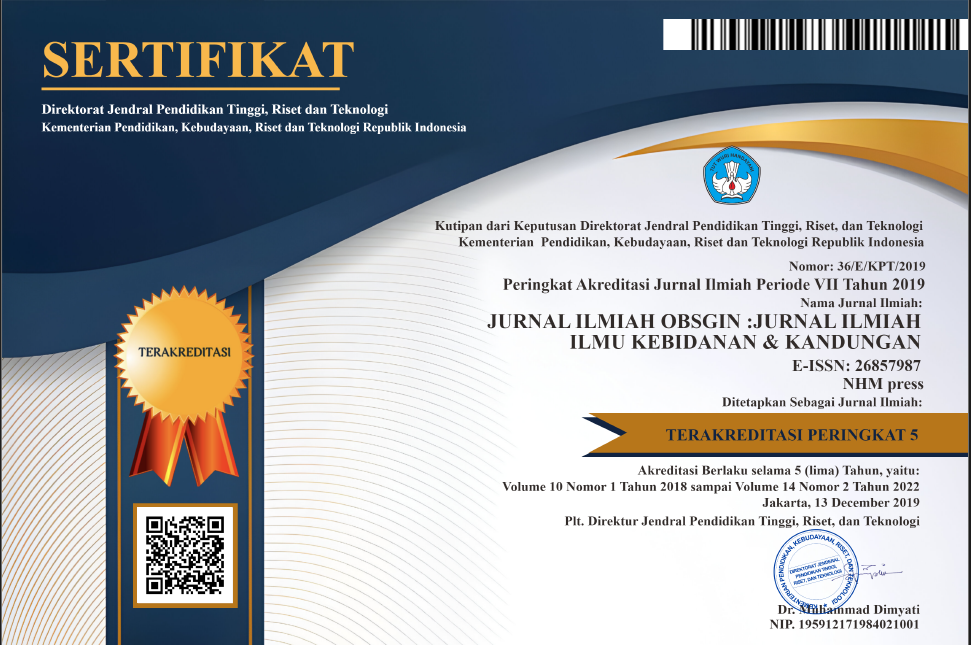HUBUNGAN PEMAKAIAN KB SUNTIK 3 BULAN DENGAN GANGGUAN HAID PADA WANITA USIA SUBUR DI PMB EKA YUSNIA WULANDARI KABUPATEN LUMAJANG
Abstract
The use of 3-monthly injectable contraceptive (Kb Suntik 3 Bulan) may cause menstrual disorders, such as shorter or even absent menstruation. This change is in line with the decrease in menstrual blood due to the use of Kb Suntik 3 Bulan. After long-term use, the amount of menstrual blood decreases and amenorrhea may occur. This study aims to determine the Relationship between the Use of 3-Monthly Injectable Contraceptive and Menstrual Disorders in Women of Childbearing Age at Eka Yusnia Wulandari Primary Health Center, Lumajang Regency.This research method employed quantitative research with a quantitative analytical design using a cross-sectional study design, with a total of 35 respondents selected through total sampling technique. The results of the study showed that the majority of respondents were users of Kb Suntik 3 Bulan, amounting to 26 respondents (74.3%), and it was found that the majority of respondents experienced menstrual disorders, amounting to 24 respondents (68.6%).From the analysis using the chi-square test, the significance value obtained was α: 0.001, which means that α <0.05, leading to the conclusion that there is a relationship between the use of Kb Suntik 3 Bulan and menstrual disorders in women of childbearing age at Eka Yusnia Wulandari Primary Health Center, Lumajang Regency.The use of Kb Suntik 3 Bulan can cause side effects, one of which is menstrual disorders. This side effect occurs because Kb Suntik 3 Bulan contains synthetic hormones that can affect the natural hormonal balance in the body. Some women may experience changes in their menstrual cycles after starting to use Kb Suntik 3 Bulan, such as cycle length, amount of blood loss, or intensity of other symptoms such as abdominal pain or discomfort.
References
Bull, J. R., Rowland, S. P., Scherwitzl, E. B., Scherwitzl, R., Danielsson, K. G., & Harper, J. (2019). Real-world menstrual cycle characteristics of more than 600,000 menstrual cycles. Npj Digital Medicine, 2(1). https://doi.org/10.1038/s41746-019-0152-7
Grieger, J. A., & Norman, R. J. (2020). Menstrual cycle length and patterns in a global cohort of women using a mobile phone app: Retrospective cohort study. Journal of Medical Internet Research, 22(6). https://doi.org/10.2196/17109
Handayani, S. (2016). Buku Ajar Pelayanan Keluarga Berencana. Pustaka Rihama.
Jannati. (2015). Hubungan Lama Pemakaian Alat Kontrasepsi Suntikan Dengan Gangguan Siklus Menstruasi Pada Akseptor KB Di Puskesmas Peukan Bada Kabupaten Aceh Besar.
Jitowiyono, s., & Rouf, M. A. (2019). Keluarga berencana (kb) dalam perspektif bidan.
Kemenkes RI. (2020). Profil Kesehatan Indonesia Tahun 2019. In Kementerian Kesehatan Republik Indonesia.
Manuaba. (2018). Pengantar Kuliah Obstretri. (I.B.G, C. I.A, & F. I.B.G, Eds.) Jakarta: Buku Kedoteran Egc.
Munayarokh, Triwibowo, M., & Rizkilillah, Z. D. M. (2014). Hubungan Lama Pemakaian Kontrasepsi Suntik DMPA dengan Gangguan Menstruasi di BPM Mariyah Nurlaili Rambe Anak Mungkid Tahun 2014. Jurnal Kebidanan, 3(6), 50–56.
Nasution, Y, R. 2021. Hubungan Kontrasepsi Hormonal Terhadap Siklus Menstruasi Pada Akseptor Kb Di Puskesmas Simpang Gambir Kabupaten Mandailing Natal Tahun 2021. Skripsi. Program Studi Kebidanan Program Sarjana Fakultas Kesehatan Universitas Aufa Royhan Di Kota Padangsidimpuan
Nuranna, L., Abdullah, I., Pratama, G., & Kayika, I. P. G. (2018). The Association between Menstrual Disorder and Work Disturbance among Employees. Indonesian Journal of Obstetrics and Gynecology, 10. https://doi.org/10.32771/inajog.v6i1.751
Proverawati, A., & Maisaroh, S. (2016). Menarche Menstruasi penuh Makna. Nuha Medika.
Pibriyanti, K., Nufus, N. T., & Luthfiya, L. (2021). of Menstruation , and Physical Activities With the Incident of Anemia in. Journal Of Nutrition College, 10, 112–119. http://ejournal3.undip.ac.id/index.php/jnc/
Riyanti, & Mahmudah. (2015). Hubungan Jenis Dan Lama Pemakaian Kontrasepsi Hormonal Dengan Gangguan Menstruasi di BPS (Bidan Praktek Swasta) Wolita M. J. Sawong Kota Surabaya. 43–51.
Roro Sekar Arum, V., Yuniastuti, A., Woro Kasmini, O., & Diponegoro, J. (2019). The Relationship of Nutritional Status, Physical Activity, Stress, and Menarche to Menstrual Disorder (Oligomenorrhea). Public Health Perspectives Journal, 4(1), 37–47. http://journal.unnes.ac.id/sju/index.php/phpj
Sumantri, W, A. (2020). Hubungan Pemakaian Kb Suntik 3 Bulan Dengan Gangguan Menstruasi Pada Ibu Di Wilayah Kerja Uptd Puskesmas Sekar Jaya Kabupaten Ogan Komering Ulu. Jurnal Kesehatan Saelmakers PERDANA. Volume 3 Nomor 2,
Setiyaningrum, E., & Aziz, Z. B. (2014). Pelayanan Keluarga Berencana Dan Kesehatan Reproduksi.











